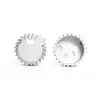Mobile:+86-311-808-126-83
Email:info@ydcastings.com
Flue End Cap Installation and Maintenance Guide for Optimal Performance
Understanding the Importance of Flue End Caps in Ventilation Systems
Flue end caps, often overlooked in the realm of building infrastructure, play a crucial role in the effective and safe operation of chimney and flue systems. These components, while small and seemingly insignificant, serve vital functions that impact both efficiency and safety. In this article, we will delve into the importance of flue end caps, their various types, materials, installation considerations, and maintenance requirements.
What is a Flue End Cap?
A flue end cap is a termination fitting that seals the top of a flue or chimney. Its primary purpose is to prevent debris, rain, and animals from entering the flue system, which can lead to blockages, inefficiencies, and even dangerous situations such as chimney fires or carbon monoxide buildup. Flue end caps are available in various designs suitable for different types of flue systems, including those used for gas, oil, and solid fuel appliances.
Functions of Flue End Caps
1. Protection from Elements Flue end caps shield the flue from rain, snow, and debris, which can compromise the effectiveness of the chimney. Without proper protection, water infiltration can lead to rusting of metal flues and deterioration of masonry materials, ultimately resulting in costly repairs.
2. Wildlife Prevention Birds and other wildlife often seek shelter in flues, which can create significant problems. An open flue can become a nesting site, blocking the passage of exhaust gases. End caps prevent animals from entering and encourage safe operation.
3. Draft Control Some flue end caps are designed to optimize airflow and improve draft. A well-designed cap can enhance the efficiency of combustion appliances by maintaining the necessary draft to facilitate proper venting of gases.
4. Spark Arrestor Certain flue end caps are equipped with features that help prevent sparks from escaping the chimney. This is particularly important for wood-burning stoves and fireplaces, where the risk of sparks igniting nearby materials can pose a significant fire hazard.
Types of Flue End Caps
flue end cap

Flue end caps come in various designs, each tailored for specific applications. Common types include
- Standard Caps Simple, round caps that provide basic protection against elements and debris. - Spark Arrestors These caps have mesh screens that catch sparks while allowing gases to escape. - Inverted Caps Designed to direct rainwater away from the flue opening, preventing moisture from entering. - Wind-Resistant Caps These aerodynamic caps help stabilize the draft in windy conditions, reducing downdrafts that can disrupt combustion.
Materials Used in Flue End Caps
Flue end caps are typically made from durable materials that can withstand high temperatures and corrosion. Common materials include
- Stainless Steel Known for its strength and resistance to rust, stainless steel is an excellent choice for flue caps, particularly those exposed to harsh outdoor conditions. - Aluminum Lightweight and cost-effective, aluminum caps are suitable for certain applications but may not provide the same longevity as stainless steel. - Cast Iron Traditional flue caps made from cast iron can be very durable, but they may be heavier and more prone to rust if not properly maintained.
Installation and Maintenance Considerations
Proper installation of flue end caps is essential for their effectiveness. It is advisable to consult with a professional chimney technician to ensure correct fitting and to check compatibility with the existing flue system.
Regular maintenance is also crucial. Homeowners should periodically inspect their flue end caps for signs of wear, rust, or damage. Cleaning the cap and ensuring that it is free from debris can help maintain optimal performance and extend the life of the flue system.
Conclusion
In conclusion, flue end caps are a small but mighty component of chimney and flue systems. Their protective functions not only enhance the safety and efficiency of venting systems but also contribute to the longevity of the entire system. Choosing the right type of flue end cap, using high-quality materials, and ensuring proper installation and maintenance are key steps in safeguarding your home and ensuring effective ventilation. As you consider your chimney and its components, don't overlook the importance of a well-designed flue end cap.
-
Why Should You Invest in Superior Pump Castings for Your Equipment?NewsJun.09,2025
-
Unlock Performance Potential with Stainless Impellers and Aluminum End CapsNewsJun.09,2025
-
Revolutionize Your Machinery with Superior Cast Iron and Aluminum ComponentsNewsJun.09,2025
-
Revolutionize Fluid Dynamics with Premium Pump ComponentsNewsJun.09,2025
-
Optimizing Industrial Systems with Essential Valve ComponentsNewsJun.09,2025
-
Elevate Grid Efficiency with High-Precision Power CastingsNewsJun.09,2025











